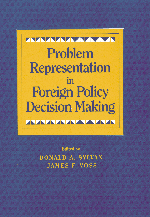Book contents
- Frontmatter
- Contents
- List of Contributors
- Part I Introducing Problem Representation
- Part II Overarching Conceptual Issues
- Part III Empirical Analysis
- 7 Problem Representations and Political Expertise: Evidence from “Think Aloud” Protocols of South African Elite
- 8 Reasoning and Problem Representation in Foreign Policy: Groups, Individuals, and Stories
- 9 Representing Problem Representation
- 10 A Problem-Solving Perspective on Decision-Making Processes and Political Strategies in Committees: The Case of Controversial Supreme Court Justice Nomination Hearings
- 11 When Gender Goes to Combat: The Impact of Representations in Collective Decision Making
- 12 Representations of the Gulf Crisis as Derived from the U.S. Senate Debate
- 13 Configuring Issue Areas: Belgian and Dutch Representations of the Role of Foreign Assistance in Foreign Policy
- Part IV Conclusion
- Index
12 - Representations of the Gulf Crisis as Derived from the U.S. Senate Debate
from Part III - Empirical Analysis
Published online by Cambridge University Press: 12 October 2018
- Frontmatter
- Contents
- List of Contributors
- Part I Introducing Problem Representation
- Part II Overarching Conceptual Issues
- Part III Empirical Analysis
- 7 Problem Representations and Political Expertise: Evidence from “Think Aloud” Protocols of South African Elite
- 8 Reasoning and Problem Representation in Foreign Policy: Groups, Individuals, and Stories
- 9 Representing Problem Representation
- 10 A Problem-Solving Perspective on Decision-Making Processes and Political Strategies in Committees: The Case of Controversial Supreme Court Justice Nomination Hearings
- 11 When Gender Goes to Combat: The Impact of Representations in Collective Decision Making
- 12 Representations of the Gulf Crisis as Derived from the U.S. Senate Debate
- 13 Configuring Issue Areas: Belgian and Dutch Representations of the Role of Foreign Assistance in Foreign Policy
- Part IV Conclusion
- Index
Summary
This chapter presents the results of an analysis of the contents of the U.S. Senate debate on the Gulf crisis. The analysis consists of using the argumentation of the debate to infer the representations of the Gulf crisis that were espoused by members of each side of the debate. Moreover, the analysis makes special use of the model of images described by R. Cottam (1977), R. Herrmann (1984, 1988), and M. Cottam (1994). Specifically, the analysis assumes that the image of Iraq held by the senators played a major role in establishing their respective representations of the crisis. Furthermore, we argue that the images provide a basis for interpreting the rhetorical features of the arguments of the senators.
There are a number of reasons for analyzing the contents of the Senate debate. First, at a relatively empirical level, it is simply of interest to extract the argumentation that was employed by each side, and it is of further interest to ascertain what can be inferred from such argumentation with respect to how the Gulf crisis was mentally represented by the senators of each side. Second, determining the images that were implied by the debate contents not only provides a basis for studying representations of the Gulf crisis; it also provides a basis for interpreting the arguments stated in the debate that were at least on the surface aimed at persuasion. Finally, analysis provides the opportunity to interpret U.S. policy with respect to Iraq in particular and the Middle East in general.
The chapter contains five sections. In the first, background information is presented that is relevant to the remainder of the chapter. In the second, the method we used to analyze the debate text is briefly described. The third section presents the analysis of the argumentation of the debate and what may be inferred regarding the problem representations and images of the senators. The final two sections present some tentative conclusions and speculations and discusses image representations.
Background Information
Brief Description of the Gulf Crisis
The Gulf crisis began in August 1990 when Iraq invaded Kuwait. In response, the United States sent troops to defend Saudi Arabia, and the Bush administration, in conjunction with the United Nations Security Council, organized an international embargo against Iraq.
- Type
- Chapter
- Information
- Problem Representation in Foreign Policy Decision-Making , pp. 279 - 302Publisher: Cambridge University PressPrint publication year: 1998
- 4
- Cited by



